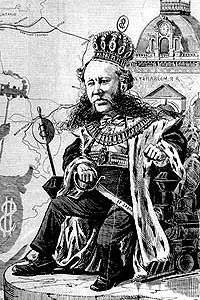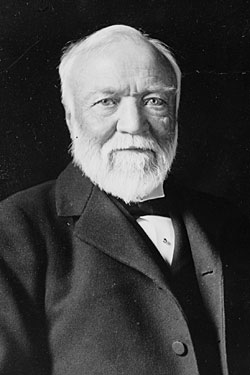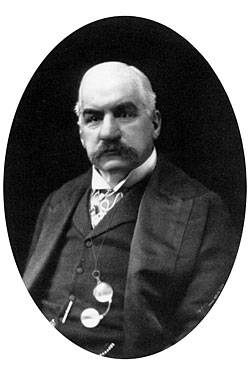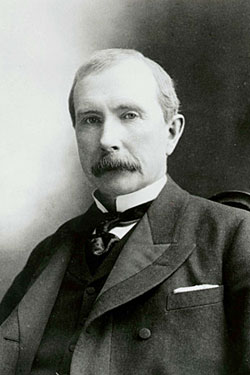 Vanderbilt as king |
Captains of Industry
Historians have used the phrase “Captains of Industry” to describe Cornelius Vanderbilt and other business tycoons or industrialists. Vanderbilt’s empire created many jobs for many people, yet he was described by many historians as unscrupulous, or thinking he was above the law. Look at the depiction of Vanderbilt. How is the artist depicting him?
Vanderbilt was born in Staten Island, New York in 1794. As a teenager, he showed entrepreneurial spirit when he used his boat to run a ferry service between Staten Island and New York City. It was the beginning of his first million dollar business venture, running steamboat ferry services with operations on both coasts of the United States. Vanderbilt was 70 years old when he began buying railroad companies. His railroad empire began with the New York and Harlem Railroad and the Hudson Railroad. By the time he finished buying railroad lines, his empire had reached Michigan and Canada. Vanderbilt was not known for his philanthropy, but he did give one million dollars to the state institution in Tennessee that became Vanderbilt University.
 Andrew Carnegie |
Andrew Carnegie was born in Scotland in 1835, and came to the United States with his family in 1848. He began working as a young boy in a cotton mill in Pennsylvania. As a teenager, he worked as an assistant to a railroad man and used the money he made to invest in railroads, bridges, and the oil industry. His investments made him rich and he used the money to build the Carnegie Steel Corporation where his friend and business associate Henry Clay Frick was the manager. Frick became the director of the United States Steel Corporation in 1901 when Carnegie sold his steel corporation for 450 million dollars to John Pierpont Morgan. Carnegie was well known for his philanthropy. He built more than 3,000 libraries across the country and gave money to colleges and struggling artists. One of his most notable endowments was the construction of Carnegie Hall built in 1891 in New York City.
 John Pierpont Morgan |
John Pierpont Morgan was born in 1837 to a wealthy Connecticut family. He made his money in the banking industry and used the money to purchase United States Steel Corporation from Carnegie, railroads, and other businesses. Morgan consolidated United States Steel Corporation with other interests to make United States Steel, the largest steel operation in the country, controlling almost two thirds of the steel industry. Morgan is also known for using the money that he controlled to bail the United States government out of debt by purchasing 200 million dollars’ worth of government bonds with gold.
 John D. Rockefeller |
The last well-known industrialist of the era was John D. Rockefeller who was born in 1839. He got his start in the oil business in 1863 as a refiner, using profits from money that he had saved. He organized the Standard Oil Company in 1870 and began to buy up oil refineries in Ohio. He also bought shops that produced the barrels to store oil and warehouses to store the barrels. All of the companies were merged into Standard Oil Trust in 1882. Rockefeller also owned other businesses including iron mines. Rockefeller was a generous philanthropist. He financially supported the Baptist church and education programs for American children. His money was also used in founding the University of Chicago and for medical research.
These Captains of Industry built the modern-day corporation. Most were also generous donors who put money back into the community and education.